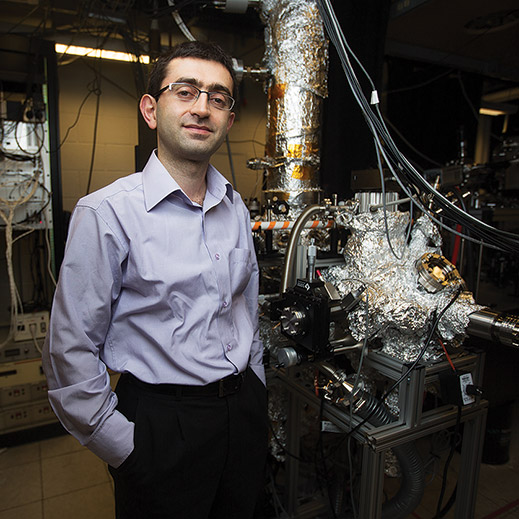Getting Photons to Play Nicely with Electrons
Researchers at MIT have succeeded in making photons and electrons “dance” together on the surface of an unusual type of material called a topological insulator. This type of coupling had been predicted by theorists but never before observed.

The researchers suggest that this finding could make it possible to create materials whose electronic properties can be tuned in real time, simply by shining precise laser beams at them. The work “opens up a new avenue for optical manipulation of quantum states of matter,” says Nuh Gedik, an associate professor of physics and senior author of a paper in Science that describes the new work.
Gedik and his team shot extremely brief pulses of mid-infrared laser light—lasting only a few hundred femtoseconds, or millionths of a billionth of a second—at a sample of the topological insulator, a solid crystalline material. They observed the results with an electron spectrometer, a specialized high-speed camera.
What they saw when the pulsed photons mixed with the exotic electrons on the material’s surface demonstrated the existence of a quantum-mechanical mixture known as a Floquet-Bloch state. Bloch states (which describe the regular, repeating movement of electrons in a crystal) are periodic in space. Floquet states (which describe how photons interact with matter) are periodic in time. Getting electrons and photons to interact in a coherent manner generates the Floquet-Bloch state, which is periodic in both time and space.
The high-speed camera captured snapshots of the never-before-seen state from its generation to its disappearance, a process lasting only a few hundred femtoseconds. The researchers also found that the material’s behavior changed when the polarization of the light changed.
Their findings suggest that it’s possible to alter the electronic properties of a material—for example, changing it from a conductor to a semiconductor—just by beaming it with light polarized in a particular way. Normally, to produce such dramatic changes in a material’s properties, “you have to do something violent to it,” Gedik says. “But in this case, it may be possible to do this just by shining light on it.”
It will take some time to assess possible applications, Gedik says. But, he suggests, this could be a way of engineering materials for specific functions. “Suppose you want a material to do something—to conduct electricity, or to be transparent, for example,” he says. “We usually do this by chemical means.” With this new method, a flash of laser light may be all that’s needed.
Keep Reading
Most Popular
Large language models can do jaw-dropping things. But nobody knows exactly why.
And that's a problem. Figuring it out is one of the biggest scientific puzzles of our time and a crucial step towards controlling more powerful future models.
The problem with plug-in hybrids? Their drivers.
Plug-in hybrids are often sold as a transition to EVs, but new data from Europe shows we’re still underestimating the emissions they produce.
Google DeepMind’s new generative model makes Super Mario–like games from scratch
Genie learns how to control games by watching hours and hours of video. It could help train next-gen robots too.
How scientists traced a mysterious covid case back to six toilets
When wastewater surveillance turns into a hunt for a single infected individual, the ethics get tricky.
Stay connected
Get the latest updates from
MIT Technology Review
Discover special offers, top stories, upcoming events, and more.